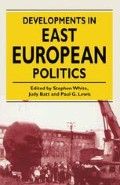Abstract
Since the events of 1989, East European politics as they have been understood for the past few decades have not so much undergone transformation and profound change as simply passed from the contemporary world stage and, in many ways, entered the realm of history. This statement may be understood to refer to both parts of the expression. For the great bulk of the post-Second World War period ‘Eastern Europe’ was made up of the territories that lay between Western Europe, for the most part closely tied in with the North Atlantic community and its gradually strengthening internal relations of economic and political cooperation, and the Soviet Union, whose specific principles of political activity and economic organisation were carefully applied to the region it then controlled in the intention of developing a rival international community distinct from and largely antagonistic to that of the West. These mechanisms of regional control were, it transpired, no longer operative in 1989 while the very basis of the regional power structure, the Soviet Union, itself collapsed in 1991.
Preview
Unable to display preview. Download preview PDF.
Editor information
Editors and Affiliations
Copyright information
© 1993 Paul G. Lewis
About this chapter
Cite this chapter
Lewis, P.G. (1993). History, Europe and the Politics of the East. In: White, S., Batt, J., Lewis, P.G. (eds) Developments in East European Politics. Palgrave, London. https://doi.org/10.1007/978-1-349-22898-0_15
Download citation
DOI: https://doi.org/10.1007/978-1-349-22898-0_15
Publisher Name: Palgrave, London
Print ISBN: 978-0-333-59190-1
Online ISBN: 978-1-349-22898-0
eBook Packages: Palgrave Political & Intern. Studies CollectionPolitical Science and International Studies (R0)

